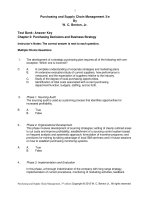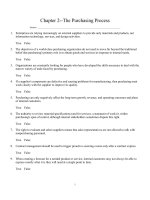Lecture Purchasing and supply chain management (3rd/e): Chapter 5 - W. C. Benton
Bạn đang xem bản rút gọn của tài liệu. Xem và tải ngay bản đầy đủ của tài liệu tại đây (606.08 KB, 15 trang )
Chapter 5:
Inventory Management
Purchasing and Supply Chain Management
3rd edition
Purchasing and Supply Chain Management, 3rd edition, Copyright © 2013, W. C. Benton Jr., All rights reserved.
Purchasing and Supply Chain Management, 3rd edition, Copyright © 2013,
1
The Nature of Demand
•
•
Independent demand
•
Demands unrelated to other finished items
•
Independently forecasted
Dependent demand
•
Demands directly derived from demand for another inventoried item
•
Raw materials, components parts, and subassemblies
2
Purchasing and Supply Chain Management, 3rd edition, Copyright © 2013, W. C. Benton Jr., All rights reserved.
5 Primary Inventory Functions
1.
Pipeline inventory
2.
Cycle stocks
3.
Seasonal inventories
4.
Safety stocks
5.
Decoupling stocks
3
Purchasing and Supply Chain Management, 3rd edition, Copyright © 2013, W. C. Benton Jr., All rights reserved.
ABC Classification
4
Purchasing and Supply Chain Management, 3rd edition, Copyright © 2013, W. C. Benton Jr., All rights reserved.
ABC Analysis Curve
5
Purchasing and Supply Chain Management, 3rd edition, Copyright © 2013, W. C. Benton Jr., All rights reserved.
Economic Order Size (EOQ) Model
•
•
EOQ is the optimal lot size for purchasing
•
Minimizes the total cost of ordering and holding inventory
•
Place an order of EOQ when the inventory levels fall below reorder
point (R)
Simplified total cost associated with inventory
Total Cost (TC)= Ordering Cost (CP)
+Holding Cost(CH)
6
Purchasing and Supply Chain Management, 3rd edition, Copyright © 2013, W. C. Benton Jr., All rights reserved.
Economic Order Size (EOQ)
7
Purchasing and Supply Chain Management, 3rd edition, Copyright © 2013, W. C. Benton Jr., All rights reserved.
Reorder Point (ROP)
8
Purchasing and Supply Chain Management, 3rd edition, Copyright © 2013, W. C. Benton Jr., All rights reserved.
Classical EOQ model Assumptions
1.
Demand is continuous at a constant rate
2.
Constant lead time
3.
Constant unit price
4.
Fixedorder cost per order
5.
Fixed holding cost per unit
9
Purchasing and Supply Chain Management, 3rd edition, Copyright © 2013, W. C. Benton Jr., All rights reserved.
Classical EOQ model Assumptions (cont.)
6.
Instantaneous replenishment
7.
No shortages allowed
8.
No demand uncertainty
9.
No quantity discounts available
10
Purchasing and Supply Chain Management, 3rd edition, Copyright © 2013, W. C. Benton Jr., All rights reserved.
2. Demand Uncertainty and Safety Stock
•
•
Relaxation
•
No demand uncertainty
•
Constant demand assumptions
A probability distribution of demands
•
E.g., Normal distribution of demands during lead time
11
Purchasing and Supply Chain Management, 3rd edition, Copyright © 2013, W. C. Benton Jr., All rights reserved.
Demand Uncertainty and Safety Stock
(cont.)
•
Safety stock
•
•
Extra inventory carried to protect against stocking out because of
demand uncertainty
What is the appropriate level of safety stock to carry?
12
Purchasing and Supply Chain Management, 3rd edition, Copyright © 2013, W. C. Benton Jr., All rights reserved.
Safety Stock (SS) and Reorder Point (ROP)
13
Purchasing and Supply Chain Management, 3rd edition, Copyright © 2013, W. C. Benton Jr., All rights reserved.
Lumpy Demands
•
For components of assembled products:
•
Demands are not usually constant
•
Inventory depletion for component parts tends to occur in discrete
“lumps” because of lot sizing of the final product
•
Requirements dependent on the final product are usually discontinuous
14
Purchasing and Supply Chain Management, 3rd edition, Copyright © 2013, W. C. Benton Jr., All rights reserved.
Questions?
15
Purchasing and Supply Chain Management, 3rd edition, Copyright © 2013, W. C. Benton Jr., All rights reserved.









